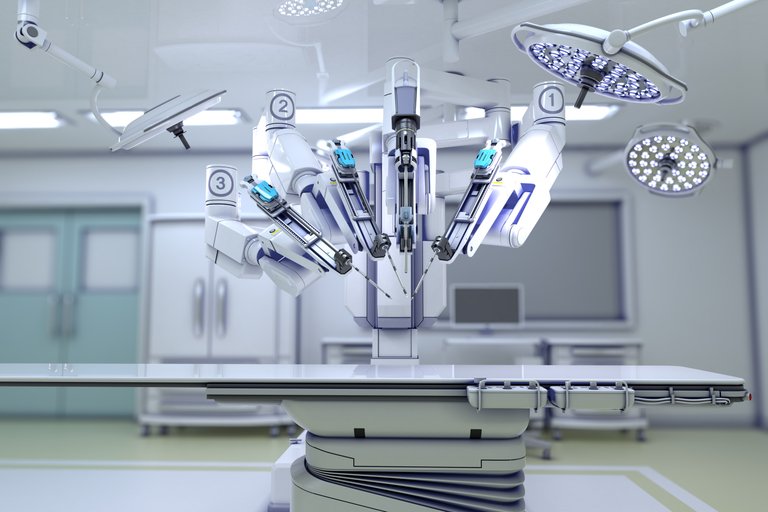
Source
The surgical robot that has accomplished this feat is not new; it is DaVinci, developed by the American company Intuitive Surgical in 2000, which we have already talked about. The da Vinci system offers the surgeon a three-dimensional and enlarged view of the surgical field, which facilitates the performance of complex procedures.
El robot cirujano que ha realizado esta proeza no es nuevo, se trata de DaVinci, desarrollado por la empresa estadounidense Intuitive Surgical en el año 2000, del que ya hemos hablado alguna vez. El sistema da Vinci ofrece al cirujano una visión tridimensional y ampliada del campo quirúrgico, lo que facilita la realización de procedimientos complejos.
The robot's instruments have a joint similar to the human wrist, allowing for precise movements that are difficult to achieve with conventional instruments. The surgeon controls the robot's instruments through a console, allowing him to perform precise and fluid movements, even remotely thousands of kilometers away.
Los instrumentos del robot tienen una articulación similar a la muñeca humana, lo que permite realizar movimientos precisos y difíciles de lograr con instrumentos convencionales, el cirujano controla los instrumentos del robot a través de una consola, lo que le permite realizar movimientos precisos y fluidos, incluso de forma remota a miles de kilómetros de distancia.

Source
Since its approval, the da Vinci system has evolved significantly. New versions have been developed with more advanced features, such as more precise instrumentation and higher-quality visualization systems. Thanks to these improvements, DaVinci has performed the world's first fully robotic double lung transplant, representing a milestone in transplant surgery and medicine.
Desde su aprobación, el sistema da Vinci ha evolucionado significativamente. Se han desarrollado nuevas versiones con características más avanzadas, como instrumentación más precisa y sistemas de visualización de mayor calidad. Gracias a estas mejoras, DaVinci ha realizado el primer trasplante pulmonar doble totalmente robotizado del mundo representa un hito en la cirugía y la medicina de trasplantes.
Performed on a 57-year-old woman with chronic obstructive pulmonary disease (COPD), the procedure involved making small incisions between the ribs to remove the damaged lungs, prepare the surgical site and transplant the new organs, all with the precision of the robotic system. The advantages of this technique include less pain, faster recovery, less risk of infections and smaller scars.
Llevado a cabo en una mujer de 57 años con enfermedad pulmonar obstructiva crónica (EPOC), el procedimiento consistió en realizar pequeñas incisiones entre las costillas para extraer los pulmones dañados, preparar el sitio quirúrgico y trasplantar los nuevos órganos, todo ello con la precisión del sistema robótico. Las ventajas de esta técnica incluyen menor dolor, recuperación más rápida, menos riesgo de infecciones y cicatrices más pequeñas.

Source
The implications of this breakthrough are clear: it improves the quality of life of patients by reducing complications and speeding up recovery. Robotic transplants can significantly improve the quality of life of patients. By making surgeries less invasive and safer, it could increase the number of organs available for transplant.
Las implicaciones de este avance son evidentes, mejora en la calidad de vida de los pacientes al reducir las complicaciones y acelerar la recuperación. los trasplantes robóticos pueden mejorar significativamente la calidad de vida de los pacientes. Al hacer que las cirugías sean menos invasivas y más seguras, podría aumentar la cantidad de órganos disponibles para trasplante.
Surgical robots allow for more precise and smaller movements than the human hand, resulting in smaller incisions, less bleeding, and a faster recovery for the patient. Robotics opens new doors to performing transplants on patients who previously might not have been candidates due to the complexity of the surgery or their health status.
Los robots quirúrgicos permiten movimientos más precisos y pequeños que la mano humana, lo que se traduce en incisiones más pequeñas, menos sangrado y una recuperación más rápida para el paciente. La robótica abre nuevas puertas para realizar trasplantes en pacientes que antes podrían no haber sido candidatos debido a la complejidad de la cirugía o su estado de salud.
More information/Más información
https://medicalxpress.com/news/2024-11-woman-world-robotic-lung-transplant.html#:~:text=A%2057%2Dyear%2Dold%20woman,lung%20transplant%E2%80%94the%20nation's%20first.